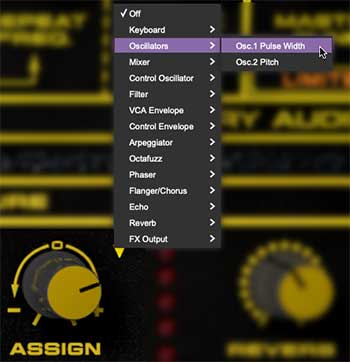Yellowjacket responds to poly aftertouch, provided your USB/MIDI controller is poly AT capable. The controls in the Keyboard Pressure (da-da-da-dadada dun) section set mod depths of various parameters. If your USB/MIDI controller only outputs mono (summed) aftertouch, this still is used to control Keyboard Pressure.

Following are all the controls for Keyboard Pressure's six mod routings. These can be used in any combination.
Volume- Overall amplitude mod depth via poly mod. Center position is none, turning the knob clockwise adds positive mod (volume gets louder with AT), turning the knob counterclockwise adds negative mod (volume gets softer with AT).
Pitch- Pitch bend depth via poly mod. The range is 12 semitones up or down. Note that up (or down) two semitones, the setting is fully variable, but past two semitones, depth snaps to semitones.
Filter- Filter cutoff frequency mod via poly mod. Note that because of the original instrument's odd built-in keyboard tracking curve, it might seem filter keyboard pressure isn't doing much - if you run into this, simply adjust the initial cutoff frequency with the Freq. knob in the Filter section to compensate.
Mod.- Control oscillator (LFO) mod via poly mod. This is the same mod routing as mod wheel. The Mod. Wheel switch in the Control Osc. section must be in the on position for Keyboard Pressure mod to operate.

Assign- This one is especially nifty. Clicking on the inverted triangle next to the knob opens a popup menu that lets you select from 29 parameters. The label beneath the knob changes to reflect the currently selected mod parameter. To reset/disable, select Off from the list. Below is a table of all possible Assign knob parameters:
|
SECTION |
PARAMETER |
|---|---|
|
Keyboard |
Unison Detune |
|
Oscillators |
Osc.1 Pulse Width |
|
Oscillators |
Osc.2 Pitch |
|
Mixer |
Osc.1 Volume |
|
Mixer |
Osc.2 Volume |
|
Mixer |
Noise Volume |
|
Control Oscillator |
Frequency |
|
Filter |
Q |
|
VCA Envelope |
Repeat Frequency |
|
Control Envelope |
Repeat Frequency |
|
Arpeggiator |
Speed |
|
Arpeggiator |
Gate |
|
Arpeggiator |
Swing |
|
Arpeggiator |
Chance |
|
Octafuzz |
Drive |
|
Octafuzz |
Tone |
|
Octafuzz |
Mix |
|
Phaser |
Frequency |
|
Phaser |
Depth |
|
Phaser |
Mix |
|
Flanger/Chorus |
Frequency |
|
Flanger/Chorus |
Depth |
|
Flanger/Chorus |
Mix |
|
Echo |
Time |
|
Echo |
Feedback |
|
Echo |
Mix |
|
Reverb |
Mix |
|
FX Output |
FX Level |
|
FX Output |
Stereo Expand |
LED Meter- The five vertical LEDs display the amount of MIDI aftertouch data Yellowjacket is currently receiving.
Reverb- This allows AT to control a combination of the reverb effect Decay and Mix amount. Note that unlike the other Keyboard Pressure routings, the Reverb routing is positive mod only (i.e., more reverb). Reverb must be enabled on the Arp./FX page for the Reverb pressure routing to work. The VCA release determines reverb decay length. Short release times will result in the reverb tail being cropped as you lift your finger from the key. Longer release times allow the reverb tail to linger, allowing you to move on to the next note while the reverb is still happening.
About controllers: Though Yellowjacket isn't MPE compatible, Keyboard Pressure plays well with controllers from Keith McMillen Instruments, CME's Xkey series, Expressive E's Osmose, and Arturia's MicroFreak. If you are using an MPE controller, it's easy enough to configure one of the axes (I looked it up, that's how you pluralize it!) to control Yellowjacket's Keyboard Pressure.